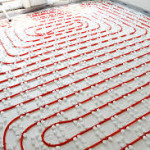Electric Underfloor Heating
 Watching ‘The Block‘ it seems Electric Underfloor Heating is very trendy these days . . . . so here are some of my thoughts:
Watching ‘The Block‘ it seems Electric Underfloor Heating is very trendy these days . . . . so here are some of my thoughts:
Advantages
- Provide a stable heat.
- Safe, with no very hot temperatures.
- Each room can be run separately.
- Quickly evaporates damp areas.
- Less air movement than other systems
Disadvantages
- Slow to heat up, and slow to cool down when heating no longer needed.
- Expensive to install and run.
- Less suitable for intermittent heating
- Less effective if under materials that have insulating properties such as carpet, or timber.
- Can damage timber floors.
Types
In Slab
The heating cables are fixed to the top layer of slab reinforcement, before the slab concrete is placed. The system heat up the whole slab, which then heats up the room above.
This system has a long warm up time making it suitable for ‘Off Peak’ tariff electricity, with the concrete slab heating up during the night and releasing the heat steadily during the day.
In Screed
With this system the heating cable is fixed on top of the slab using a light steel mesh, or fixing strips. The cables are covered with 15-25mm of screed.
In screed system which tend to heat less of the slab have faster warm up times than ‘In Slab’ systems and can be considered as ‘direct’ acting system with some storage characteristics.
Under Tile
Under Tile heating consists of a thin heating cable pre-laid on a self adhesive fibreglass mesh which is then covered with the tile adhesive.
This system has the fastest heating up time but the least amount of heat storage.
Finally
I can’t say I am keen on underfloor heating as I used to work in an office that had it many years ago. . . It caused my feet to sweat excessively with predictable effects when I went home and took my shoes off!
If I was going to use it at all I would probably favour just a ‘Under Tile’ system for bathrooms.
See Heating for more posts